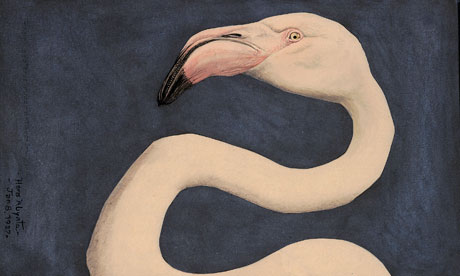Happy birthday Edward Lear
'Old Derry down Derry', still known as one of the best painters of exotic birds as well as the master of nonsense verse, celebrates his bicentenary on 12 May

One of the best … painting of a flamingo, by Edward Lear. Photograph: Field Museum Library/Getty Images
"Old Derry down Derry" is 200 years old on 12 June. This is the pseudonym that Edward Lear used for his first book of limericks, A Book of Nonsense (1846). It gives a hint of where in the history of nonsense he positioned himself, as versions of "Derry down derry" can be found across the folk-songs and plays of Britain and Ireland. Quite why this deeply troubled man ended up disturbing the decorum of Victorian life and language is not totally clear. His life's love was for art. He yearned to produce a masterpiece of landscape painting but ended up with a series of empty, moody canvases. He was a quiet, atmospheric watercolorist who illustrated his travels with real feeling. He is still known as one of the best painters of exotic birds, but it's the combination of his absurd words and scratchy line-drawings that has survived the best.
The nonsense writing came about during his stays at the Knowsley estate of Lord Stanley, who had hired the young Lear to paint his menagerie. The adults noticed the children disappearing off to the steward's room, and when they found that they were seeking out the funny drawings, poems and stories of the young painter, he was summoned upstairs, where he carried on entertaining everybody. It wasn't entirely easy, with Lear observing: "the uniform apathetic tone assumed by lofty society irks me dreadfully … nothing I long for half so much as to giggle heartily and to hop on one leg down the great gallery – but dare not."
He may not have hopped, but he produced a gallery of people who tore off their hair, ate thousands of figs, murdered themselves with forks, died of despair, and were troubled by dreams, baked in a stove, eaten by a puppy, split in two but mended with very strong glue. This is a catalogue of disruption of bodies even as society was tying them up in corsets and waistcoats – but then Lear's own body was disrupted by his secret and stigmatised illnesses: epilepsy and depression.
Later, he found the voice of ever-wandering creatures – a Pobble, a Dong, a Scroobius Pip and Jumblies – that are often on the hunt for a love they don't find. Perhaps these are skewed versions of Lear himself, just as his mock botanical textbooks are glorious misrepresentations of the Victorians' quest to name everything.
A full calendar of celebrations can be found atnonsenselit.wordpress.com/. Tomorrow I will be attending a plaque ceremony at Lear's home in Stratford Place, London W1 and the day after I'll be performing a Lear tribute with Roger McGough at the British Library. I'm also looking forward to broadcasting Lear from a phone box outside the Story Museum, in Oxford.
